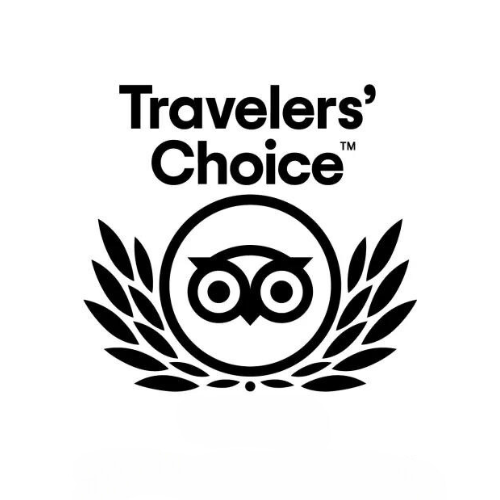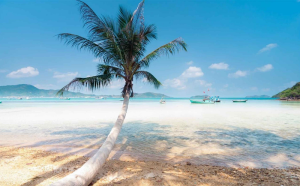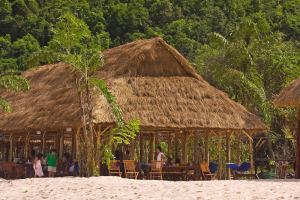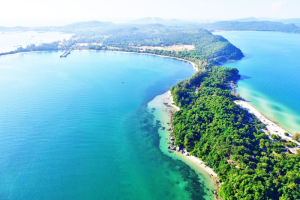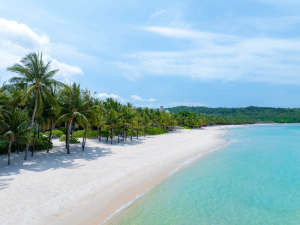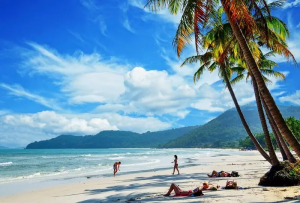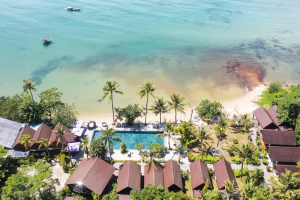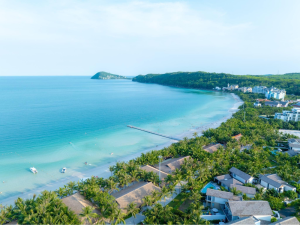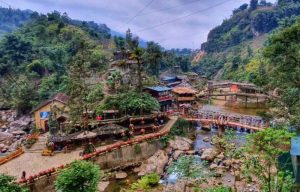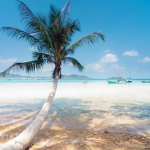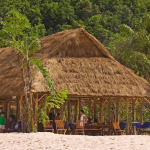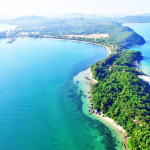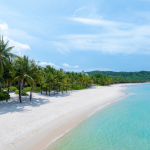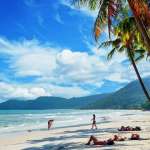Monkey Pagoda is one of Vung Tau’s unique draws, combining natural views, spiritual atmosphere, and intimate contact with animals. Officially known as Thien Vien Truc Lam Chan Nguyen, this serene Buddhist temple sits at the base of Ky Van mountain and is famously infested with an enormous troop of wild monkeys. No matter if you’re an outdoors person, a photographer, or a culture vulture, the Monkey Pagoda is an unforgettable destination for all ages.

Where is Monkey Pagoda and what makes it special?
Monkey Pagoda, formally known as Thien Vien Truc Lam Chan Nguyen, is located at the foot of Ky Van (also called Minh Dam) mountain in Phuoc Hai commune, Dat Do district, Ba Ria – Vung Tau province. It’s approximately 20 kilometers east of central Vung Tau city, a convenient day trip for local and international tourists alike seeking a peaceful escape from the coastal bustle.
What distinguishes the Monkey Pagoda is how it stands in complete harmony with its serene natural surroundings as much as with traditional Truc Lam Zen Buddhist architectural design. The temple compound is overgrown with dense greenery, with hills clothed in forest, natural rock outcrops, and wooden shrines all blending together to provide an ambiance of peace and reflection. Established in 1990 as a modest hermitage, the compound was later expanded under the guidance of Venerable Thich Thong Luan. The pagoda now consists of a main hall built into the mountainside and several small meditation huts hidden among the ancient trees, inviting the visitor to meditate, unwind, and unite with nature. Its isolation yet accessibility make it a unique spiritual and ecological site in southern Vietnam.

Wild monkeys at the pagoda: What visitors should know
Among the prime attractions of a trip to Monkey Pagoda is being able to witness more than 200 wild long-tailed macaques freely roaming the temple grounds. The monkeys come to the pagoda almost regularly from the surrounding forests and have, over time, become used to the presence of monks and travelers. Their naughty antics and inquisitive nature have made them the iconic image of the pagoda.
Even if they seem friendly, do not forget that they are wild animals. Tourists should avoid staring directly at the macaques since this might be misinterpreted as a threat. To experience a safe and respectful encounter, keep all personal belongings – especially food and reflective objects – well tucked in. Avoid offering food and touching the monkeys with your hands, as this might lead to hostile reactions such as snatching food or unintentional biting.
For photography enthusiasts, the Monkey Pagoda offers limitless opportunities to take intriguing wildlife photographs. However, it is advisable to use a zoom lens in photographing the monkeys rather than approaching them closely. Staying at a distance not only ensures protection but also preserves the symbiosis between the temple’s visitors and its hairy residents.

Read more: Catch the waves: Mui Ne surfing hotspots
How to plan your trip to Monkey Pagoda
Below is some of the essential information that is valuable for your upcoming trip to Monkey Pagoda.
Getting there
Travelers have two major route options to go to the Monkey Pagoda, based on where they are departing from. Departing from the city of Vung Tau, drive along the scenic DT44A coastal road east towards Long Hai. As you travel, you will pass through the picturesque Deo Nuoc Ngot (Sweet Water Pass), and after which it is roughly another 4 kilometers before signboards will guide you to Thien Vien Truc Lam Chan Nguyen. The whole journey is around 20 kilometers and under an hour by motorbike or car.
Alternatively, travelers starting in Ba Ria city can drive along Highway 55, and then branch southeast onto DT44A for some 23 kilometers to reach Monkey Pagoda. Both roads are paved and relatively smooth, with pretty views of the hillside and coastline along the way.
Transportation is by motorbike, private car, or tour van. Motorbikes appeal to the adventurous traveler who craves scenic liberty, especially on sunny days. Cars and vans are more comfortable and better sheltered from Vietnam’s unexpected rain showers and are ideal for families or groups of six or more.
Recommended time of day for visits and avoiding crowds
The optimal time to visit Monkey Pagoda is during the early morning between 8:00 AM and 9:30 AM, or late afternoon from 3:00 PM to 4:00 PM. The weather during these periods is more comfortable, and the wild macaques tend to be seen as they emerge for food and play. They are also the optimal times for photography using softer natural light.
To avoid crowds, visit during weekdays. The arid winter months from November through April are optimal for outside visiting because of clearer skies and reduced humidity. Weekends and the rainy season (May through October) draw more people and less predictable weather, which can detract from views and make trails slippery.
What to bring, wear, and prepare for
Relaxation and readiness are of paramount importance when traveling to Monkey Pagoda, especially due to its hilly location and wildlife. Wear light, loose-fitting clothes suitable for Vietnam’s tropical climate and opt for well-padded walking shoes or hiking sandals with tread, as the stone pathways and forest trails may be uneven or slippery.
Each guest should carry at least one liter of drinking water since it is still important to stay hydrated in the shaded areas. A hat, sunblock, and insect repellent should be carried in order not to get exposed to the sun, as well as insect bites present in the woods. Despite the abundance of shade, midday remains hot.
If you plan to photograph or just observe monkeys, take sealed snacks and put them inside a safe bag. Hand-feeding monkeys is strongly not recommended; feed food from afar to avoid encouraging aggressive behaviors. Take along also a fully charged camera or smartphone, and take with you a portable charger because there are no electrical outlets available on site.

What to see and do at Monkey Pagoda
Monkey Pagoda offers a range of unique experiences that blend spiritual exploration with natural discovery. Whether you’re drawn by the architecture, the wildlife, or the serene environment, there are several highlights worth noting:
Main meditation hall
The main hall of Monkey Pagoda is actually carved directly into the mountainside, seamlessly integrating with the rock formations. Within, Buddha statues and delicately carved hand-reliefs demonstrate the artistry and spiritual depth of Truc Lam Zen Buddhism. Tranquil surroundings make it an ideal spot to indulge in peaceful contemplation or merely soak up the integration of nature and structure.
Forest trails
Winding through thick foliage, the forest paths surrounding the pagoda lead to small wooden cabins occupied by monks for seated meditation. Shaded roads are ideal for gentle strolls and offer a feeling of isolation seldom found at busier sites. Bird songs, rustling leaves, and distant monkey cries create an immersed natural ambiance that promotes mindfulness.
Monkey viewing platforms
Certain areas around the temple offer ideal spots to observe the macaques while maintaining a respectful distance. These rock benches and open platforms offer front-row seats to the monkeys as they groom, rummage, and socialize in a group. Carefully watch in silence and never move quickly in order to capture true moments – this is also the time when a zoom lens works most effectively for photographers.
Scenic overlooks
A climb to the higher terraces around Monkey Pagoda rewards travelers with sweeping views of Long Hai’s coastline and the surrounding forest. Sunrise and sunset are especially captivating, offering golden light over the sea and mountains that makes for unforgettable photos. These vantage points also serve as peaceful rest stops during your visit.
Neighboring attractions
Proceed to nearby Minh Dam Mountain, with wartime ancient caverns and memorial grounds. It is just a few minutes’ drive from Monkey Pagoda and adds historical significance to your trip. To conclude the day at leisure, Long Hai Beach has tranquil waves and soft sand within a few minutes and is ideal for lunch, sunbathing, or an afternoon swim.

Don’t wait – plan your dream tour with Lily’s Travel! Since 2007, Lily’s Travel has led the way in Northern Vietnam tourism, earning over 2,000 five-star Tripadvisor reviews and top rankings among Hanoi’s agencies. Our expert designers craft Vietnam–Laos–Cambodia journeys that seamlessly blend stunning scenery with insightful cultural discoveries. Powered by 4.0 technology, we let you preview tours in immersive 3D, ensuring you know exactly what to expect. With a young, energetic team committed to sustainable, community-focused travel, Lily’s Travel delivers professional, heartfelt service that turns every trip into a lasting memory.
Monkey Pagoda is a destination that captures the heart of Southern Vietnam – calm, wild, and culturally rich. Whether you come for the monkeys, the meditation paths, or the panoramic views, you’ll find peace and adventure in equal measure. Don’t miss this hidden gem on your next journey through Ba Ria – Vung Tau province.
Read more: Tips for a safe and enjoyable visit to Nuoc Ngot Pass

